Jeskyně Na Turoldu
Na Turoldu Cave
Useful Information
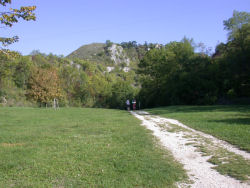
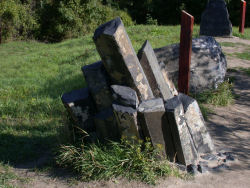
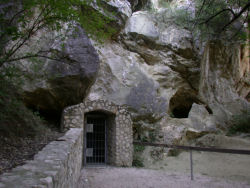
| Location: |
U Lomu 696, 692 01 Mikulov na Moravě.
Near Mikulov. Located at the border to Austria, border crossing Mikulov-Drasenhofen. South of Brno. From D2/E65 Brono-Breclav use exit 41 Podivin (from south) or exit 25 Hustopece (from north). Follow parallel road in the same direction to the turnoff of road 421 to Mikulov. (48.8164105, 16.6403764) |
| Open: |
APR daily 9-16. MAY Tue-Sun 9-16:30. JUN to AUG daily 9-17. SEP to 15-NOV Tue-Fri 10-16, Sat-Sun 9-16:30. Night Tours: JUL to AUG Mon 19-21. [2024] |
| Fee: |
Adults CZK 170, Children (3-15) CZK 100, Children (0-2) free, Students (-26) CZK 140, Disabled CZK 100, Disabled (3-15) free, Seniors (65+) CZK 140. Groups: Children CZK 50. Photography Permit CZK 30, Video Permit CZK 100. [2024] |
| Classification: |
 Karst Cave Karst Cave
 Hypogene Caves Hypogene Caves
|
| Light: |
 Incandescent Incandescent
|
| Dimension: |
L=1,650 m, VR=47 m, T=7-9 °C, Twater=6 °C, H=74-84 %. Jeskyně Na Turoldu - Liščí díra: L=3.1 km. |
| Guided tours: | L=280 m, D=60 min, St=350, Min=4, Max=15. |
| Photography: | allowed, no flash, selfie stick or tripod |
| Accessibility: | no |
| Bibliography: |
Jirí Gaisler, Josef Chytil (2002):
Mark-recapture results and changes in bat abundance at the cave of Na Turoldu, Czech Republic,
Folia Zoologica vol. 51 no. 1, pp 1-10 (2002)
pdf-file
|
| Address: |
Správa jeskyně Na Turoldu, Jiří Kolařík, U Lomu 54, 69201 Mikulov, Tel: +420-519-321-718.
E-mail: Cave Administration of the Czech Republic, Květnové náměstí 3, CZ-252 43 Průhonice, Tel: +420-271-000-040. E-mail: |
| As far as we know this information was accurate when it was published (see years in brackets), but may have changed since then. Please check rates and details directly with the companies in question if you need more recent info. |
|
History
| 1669 | first mentioned in a medical book written in Latin by Jan Ferdinand Hertod of Todtenfeld, a native of Mikulov, named Tartaro - Mastix Moraviae etc. |
| 1835-1842 | detailed descriptiuon published in Gregor Wolny, Die Markgrafschaft Mähren topographisch, statistisch und historisch geschildert. |
| 1934 | limestone quarrying ends. |
| 10-MAY-1946 | Turold Nature Reserve created with an area of 16 ha. |
| 1949 | Speleologického klubu v Brně (Brno Speleological Club) founded in Mikulov. |
| 27-OCT-1951 | a team of this caving club led by Benedikt Závada, succeeded in breaking into the first large spaces in the south wall of the quarry. |
| 1952–1954 | several exploration tours, discovery of 470 m of cave passages. |
| 1958 | start of bat monitoring. |
| 1958 | show cave opened after simple landscaping with wooden steps and electric light. |
| 1967 | due to the serious illness of the main initiator and administrator of the show cave, Antonín Holan, it was closed again. |
| 1974 | The reopening of the show cave was discussed and rejected, but at least the cave was closed with a fixed door, remeasured and very well documented. |
| 1999 | start of development. |
| 2004 | opened to the public with the financial support of sponsors and the Mikulov Municipal Authority. |
| 2006 | managed by the Cave Administration of the Czech Republic. |
Description
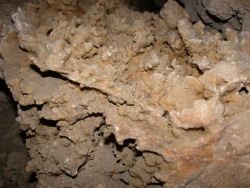
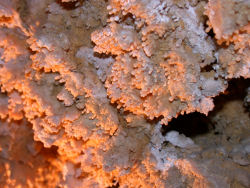
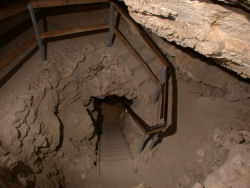
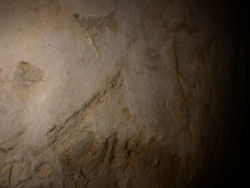


Jeskyně na Turoldu is the newest show cave of the Czech Republik, and was opened in 2004. The cave is located in the Jurassic limestones of the Palavske vrchy hills, and is part of the Pálava UNESCO Biosphere Reserve. As most caves in the Czech Republic, especially the big ones, have formed in Devonian limestones, the Jeskyně Na Turoldu-Liščí díra cave system is actually the longest cave in Jurassic limestones with a length of 3.1 km. The cave has seven levels. Speleological exploration in the Jeskyně Na Turoldu-Liščí díra system is still ongoing, and every year cavers increase the total length.
The landscape along the Austrian-Czech border is a fertile plain, a renowned wine-growing area. And right north of the border lies a sort of mountain called Kocici skala (Cat’s mountain), limestone hills raising 530 m asl from the plain at about 200m asl. This area is called the Jihomoravský Kras (South Moravian Karst) and is 10 km long and 7 km wide. The karst has mostly Jurassic, but also some Cretaceous limestones. The hills belong to the Západní Karpaty (West Carpathian) Mountains, at least geologically, as the Carpathian Mountains actually begin at the Danube, about 80 km southeast. The southernmost hill is called Turold Hill (385 m asl) and contains the homonymous Jeskyně na Turoldu. The area is very rich in caves, the Turold Hill only has 18 caves which are known so far. The hill was quarried for the limestone which was used to build the houses of the village of Mikulov and around. During the quarrying, several caves were discovered, but later destroyed by the continuing quarrying.
The ticket office of Na Turoldu lies on the northern end of the village Mikulov, close to the Amfiteátr (open air theatre) and the police station. It was built at the entrance to the abandoned quarry. A short walk leads to the far end of the quarry, where the quarry floor was used to create a sort of geologic trail or rock exhibition. All kinds of rocks from the area were placed here, including crystalline rocks and basaltic columns. This is a good place to spend the waiting time for the next tour.
The cave is entered through a steel door, and soon the typical character of the cave becomes obvious: it is very dry, almost dusty, and it is a series of steep clefts and stairs. The cave formed obviously by a combination of tectonic forces and solution. There was never a cave river, there are no stalactites or stalagmites. But the cave was once filled with carbonate rich water for a very long time, and so huge layers of calcite crystals formed. Walls are covered by crystals, by bulbous calcite and sometimes by moonmilk.
The first chamber is named Old Hall, and is the section which was first discovered. A huge rock is called Guard, unfortunately it did not guard very well, and the speleothems of this section were broken off and removed by the quarry workers and early visitors. From here the trail goes in circles continually down, the cave does not have shafts, but it is a three-dimensional labyrinth and its vertical extension is bigger thanb the horizontal. The next chamber was named Balvanitého dómu (Boulder Dome) after huge blocks broken away from the ceiling. A wooden staircase leads down to the Klenotnice (Treasury), with snowy walls corroded into extraordinarily rugged spaces and small cavities. The lustrous crystals of pure calcite were named turoldská výzdoba (Turold decoration), because they can be found in no other cave in the Czech Republic. The Shark Jaws Hall was named after a formation which actually resembles shark teeth. Another descent leads to the Netopýřího dómu (Bat Dome). The snowy-white ceilings are covered with brownish stains caused by iron oxides and with small black dots caused by manganese oxides. Finally, the Síně konce (End Hall) is reached, which contains a small exhibition of bones of mammoth, buffalo, prehistoric horse and bear. They were found during quarrying, in caves which have been destroyed in the process. There is also an exhibition of Mesozoic fossils of bivalves and gastropods from the Pálava Hills. A side branch leads from the Bat Dome to the Pohádkové síně (Fairytale Hall). The weathered dolomite has bizarre shapes, the floor is covered by white limestone sand, which is rare in caves. Now the tour returns to the surface on the same way.
The water level is the karst water level, which is connected to the surrounding plains. It seems it was much lower when the cave was first developed as a show cave, as the lowest part of the tour is not guided any more. The risen water level is only one reason for this, the other reason is a lake of carbon dioxide. This gas is heavier than the normal air and collects at the bottom of the cave. Unfortunately, the gas, while not really dangerous or poisonous itself, does not contain any oxygen, so people entering the carbon dioxide lake soon suffocate while still breathing. The carbon dioxide is produced deep below the cave, and rises through the fissures in the rock.
This is one of the caves which were not created by surface carbon dioxide, but by carbon dioxide from below.
This type of caves is called
 Hypogene Caves.
They are actually not uncommon, but they are not as common as normal caves.
And the scientific process of analyzing this process was rather slow, they were not recognized by most speleologists.
This changed with Alexander B. Klimchouk, a famous geologist and speleologist who worked at the National Academy of Sciences of Ukraine.
He did years of research and wrote a lot of publications, and our knowledge about this process today was mostly explored by him.
Unfortunately, he deceased a few years ago.
The hypogene cave formation is one sort of corrosion and beneath erosion responsible for a certain amount of cave formation in most caves.
However, some caves like this one were formed almost entirely by hypogene processes.
Hypogene Caves.
They are actually not uncommon, but they are not as common as normal caves.
And the scientific process of analyzing this process was rather slow, they were not recognized by most speleologists.
This changed with Alexander B. Klimchouk, a famous geologist and speleologist who worked at the National Academy of Sciences of Ukraine.
He did years of research and wrote a lot of publications, and our knowledge about this process today was mostly explored by him.
Unfortunately, he deceased a few years ago.
The hypogene cave formation is one sort of corrosion and beneath erosion responsible for a certain amount of cave formation in most caves.
However, some caves like this one were formed almost entirely by hypogene processes.
This cave is the largest known bat hibernation site in the territory of the reserve. It is the largest hibernation site for the endangered Lesser Horseshoe Bat (Rhinolophus hipposideros) in South Moravia. Bats have been monitored since 1958, the total number of species found in the cave is 15. Even during summer, about 250 bats can be seen on the tour in the Bat Hall.
- See also
 Member of the International Show Caves Association (ISCA)
Member of the International Show Caves Association (ISCA) Search DuckDuckGo for "Jeskyně na Turoldu"
Search DuckDuckGo for "Jeskyně na Turoldu" Google Earth Placemark
Google Earth Placemark OpenStreetMap
OpenStreetMap NA TUROLDU CAVE, Cave Administration of the Czech Republic official site
NA TUROLDU CAVE, Cave Administration of the Czech Republic official site Ceská Speleologická Spolecnost the page of the local caving club with some info on the cave. (
Ceská Speleologická Spolecnost the page of the local caving club with some info on the cave. ( )
)
 Index
Index Topics
Topics Hierarchical
Hierarchical Countries
Countries Maps
Maps